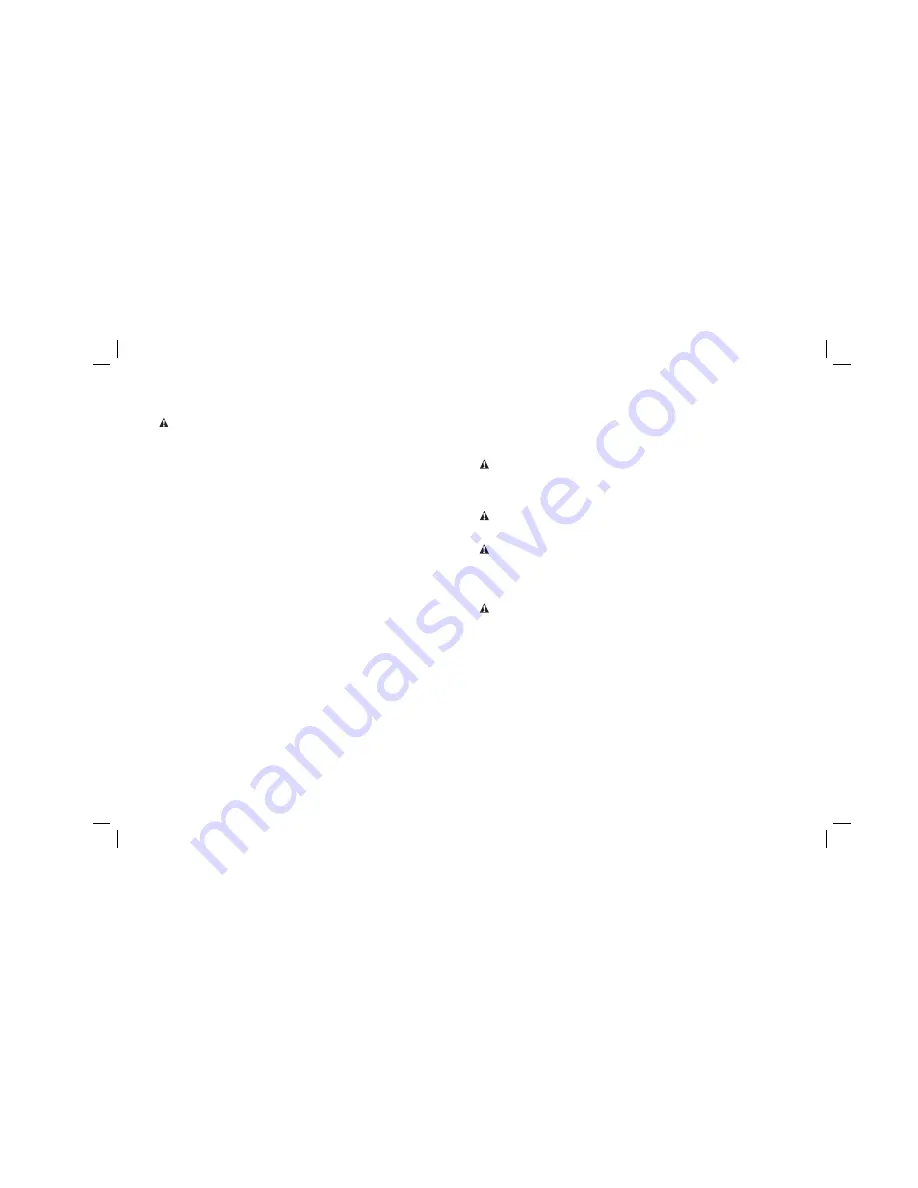
16
USING CUTTING WHEELS
WARNING:
Do not use edge grinding/cutting wheels for surface grinding applications
because these wheels are not designed for side pressures encountered with surface
grinding. Wheel breakage and injury may result.
1. Allow tool to reach full speed before touching tool to work surface.
2. Apply minimum pressure to work surface, allowing tool to operate at high speed.
Cutting rate is greatest when the tool operates at high speed.
3. Once a cut is begun and a notch is established in the workpiece, do not change
the angle of the cut. Changing the angle will cause the wheel to bend and may
cause wheel breakage.
4. Remove the tool from work surface before turning tool off. Allow the tool to stop
rotating before setting it down.
Causes and Operator Prevention of Kickback
• Kickback is a sudden reaction to a pinched, bound or misaligned wheel, wire
brush or flap disc causing an uncontrolled cut-off tool to lift up and out of the
workpiece toward the operator.
• When the wheel is pinched or bound tightly by the workpiece, the wheel stalls
and the motor reaction drives the unit rapidly back toward or away from the
operator.
• Kickback is the result of tool misuse and/or incorrect operating procedures or
conditions and can be avoided by taking proper precautions as given below:
•
Maintain a firm grip with both hands on the unit and position your body and
arm to allow you to resist kickback forces.
Kickback forces can be controlled
by the operator, if proper precautions are taken.
•
When wheel is binding, or when interrupting a cut for any reason, release the
trigger and hold the unit motionless in the material until the wheel comes to a
complete stop. Never attempt to remove the unit from the work or pull the unit
backward while the wheel is in motion or kickback may occur.
Investigate and
take corrective actions to eliminate the cause of wheel binding.
•
When restarting a cut-off tool in the workpiece, check that the wheel is not
engaged into the material.
If wheel is binding, it may walk up or kickback from
the workpiece as the tool is restarted.
•
Support large panels to minimize the risk of wheel pinching and kickback.
Large panels tend to sag under their own weight. Support must be placed under
the panel on both sides, near the line of cut and near the edge of the panel.
MAINTENANCE
WARNING:
Shock Hazard. To reduce the risk of serious personal injury, turn
tool off and disconnect tool from power source before making any adjustments or
removing/installing attachments or accessories.
Cleaning
WARNING:
Blow dirt and dust out of all air vents with clean, dry air at least once
a week. To minimize the risk of eye injury, always wear ANSI Z87.1 approved eye
protection when performing this.
CAUTION:
Never use solvents or other harsh chemicals for cleaning the non-
metallic parts of the tool. These chemicals may weaken the plastic materials used in
these parts. Use a cloth dampened only with water and mild soap. Never let any liquid
get inside the tool; never immerse any part of the tool into a liquid.
CHARGER CLEANING INSTRUCTIONS
WARNING:
Shock hazard. Disconnect the charger from the AC outlet before
cleaning. Dirt and grease may be removed from the exterior of the charger using a
cloth or soft non-metallic brush. Do not use water or any cleaning solutions.
Lubrication
Your tool was properly lubricated before leaving the factory. In from two to six
months, depending upon use, take or send your tool to an authorized service
center for a complete cleaning, inspection and lubrication. Tools used constantly on
production jobs will need relubrication more often. Also, tools “out of service” for long
periods should be relubricated before being put back to work.
Repairs
This charger is not user serviceable. There are no user serviceable parts inside the
charger. Servicing at an authorized service center is required to avoid damage to static
sensitive internal components.



































